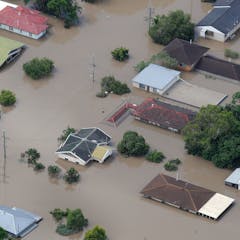
Articles on Carbon sinks
Displaying 61 - 80 of 80 articles

‘Hothouse Earth’ is not a sure thing – yet. Here’s what you can do about it.

Fish are a key food source for millions of people worldwide. But a recent study finds long-term warming over the next 200 years could starve tiny plankton, with impacts that would ripple up food chains.

The pioneering legislation is ten years old – and the latest science means it now does not go far enough.

After three years in which global carbon emissions scarcely rose, 2017 has seen them climb by 2%, as the long-anticipated peak in global emissions remains elusive.

Last week Brazil opened thousands of kilometres of previously protected Amazon rainforest to mining, in a bid to combat ongoing political and economic disasters.

Why is it so hard to reach consensus about how to slow climate change? Multiple time lags get in the way: some make it hard to convey the risk, while others prolong the search for solutions.

In an extract from his new book, Tim Flannery explains how giant kelp farms could suck carbon dioxide from the air and store it in the ocean’s depths, while encouraging species like fish and oysters.

Can forests effectively remove carbon from the atmosphere?

Mangroves are superheroes on both land and sea, storing carbon and providing protection for coasts.

A swampy area the size of England stores as much carbon as 20 years of US fossil fuel emissions.

Extreme wet years are getting wetter and more common. This means Australia’s terrestrial ecosystems will play a larger role in the global carbon cycle.

Australia is pumping 6.5 times more carbon into the atmosphere than the land can absorb.

Study shows mangrove forests along desert coasts have potential to lock up large amounts of carbon and buffer against rising seas.

Since 1999, Australia has swung between drought and deluge with surprising speed, because El Niño has fallen into sync with similar patterns in the Indian and Southern Oceans.

Fossil fuel emissions are slowing, but another major climate problem is becoming clear: food production.

Sharks and other ocean predators help protect the ocean’s carbon stores by keeping other wildlife in check.

Forests take longer than expected to rebound from droughts, diminishing their role as global carbon sinks.

Mangroves, hectare for hectare, store more carbon than any other forests. But they are also among the most threatened. New projects in Indonesia show how mangroves might be restored.

It’s no exaggeration to say the tropics drive our planet’s carbon cycle – the constant transfer of carbon back and forth, on a global scale, between living things and the environment. Understanding the…

Record-breaking rains triggered so much new growth across Australia that the continent turned into a giant green carbon sink to rival tropical rainforests including the Amazon, our new research shows…
